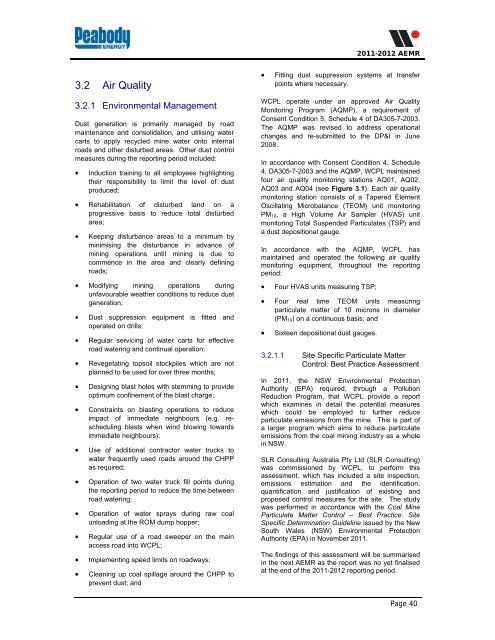Wambo Coal AEMR 2011-2012 - Peabody Energy
Wambo Coal AEMR 2011-2012 - Peabody Energy
Wambo Coal AEMR 2011-2012 - Peabody Energy
Create successful ePaper yourself
Turn your PDF publications into a flip-book with our unique Google optimized e-Paper software.
<strong>2011</strong>-<strong>2012</strong> <strong>AEMR</strong><br />
3.2 Air Quality<br />
<br />
Fitting dust suppression systems at transfer<br />
points where necessary.<br />
3.2.1 Environmental Management<br />
Dust generation is primarily managed by road<br />
maintenance and consolidation, and utilising water<br />
carts to apply recycled mine water onto internal<br />
roads and other disturbed areas. Other dust control<br />
measures during the reporting period included:<br />
<br />
Induction training to all employees highlighting<br />
their responsibility to limit the level of dust<br />
produced;<br />
Rehabilitation of disturbed land on a<br />
progressive basis to reduce total disturbed<br />
area;<br />
<br />
Keeping disturbance areas to a minimum by<br />
minimising the disturbance in advance of<br />
mining operations until mining is due to<br />
commence in the area and clearly defining<br />
roads;<br />
Modifying mining operations during<br />
unfavourable weather conditions to reduce dust<br />
generation;<br />
<br />
<br />
<br />
<br />
<br />
<br />
<br />
<br />
<br />
<br />
<br />
Dust suppression equipment is fitted and<br />
operated on drills;<br />
Regular servicing of water carts for effective<br />
road watering and continual operation;<br />
Revegetating topsoil stockpiles which are not<br />
planned to be used for over three months;<br />
Designing blast holes with stemming to provide<br />
optimum confinement of the blast charge;<br />
Constraints on blasting operations to reduce<br />
impact of immediate neighbours (e.g. rescheduling<br />
blasts when wind blowing towards<br />
immediate neighbours);<br />
Use of additional contractor water trucks to<br />
water frequently used roads around the CHPP<br />
as required;<br />
Operation of two water truck fill points during<br />
the reporting period to reduce the time between<br />
road watering;<br />
Operation of water sprays during raw coal<br />
unloading at the ROM dump hopper;<br />
Regular use of a road sweeper on the main<br />
access road into WCPL;<br />
Implementing speed limits on roadways;<br />
Cleaning up coal spillage around the CHPP to<br />
prevent dust; and<br />
WCPL operate under an approved Air Quality<br />
Monitoring Program (AQMP), a requirement of<br />
Consent Condition 5, Schedule 4 of DA305-7-2003.<br />
The AQMP was revised to address operational<br />
changes and re-submitted to the DP&I in June<br />
2008.<br />
In accordance with Consent Condition 4, Schedule<br />
4, DA305-7-2003 and the AQMP, WCPL maintained<br />
four air quality monitoring stations AQ01, AQ02,<br />
AQ03 and AQ04 (see Figure 3.1). Each air quality<br />
monitoring station consists of a Tapered Element<br />
Oscillating Microbalance (TEOM) unit monitoring<br />
PM 10, a High Volume Air Sampler (HVAS) unit<br />
monitoring Total Suspended Particulates (TSP) and<br />
a dust depositional gauge.<br />
In accordance with the AQMP, WCPL has<br />
maintained and operated the following air quality<br />
monitoring equipment, throughout the reporting<br />
period:<br />
<br />
Four HVAS units measuring TSP;<br />
Four real time TEOM units measuring<br />
particulate matter of 10 microns in diameter<br />
(PM 10) on a continuous basis; and<br />
<br />
Sixteen depositional dust gauges.<br />
3.2.1.1 Site Specific Particulate Matter<br />
Control: Best Practice Assessment<br />
In <strong>2011</strong>, the NSW Environmental Protection<br />
Authority (EPA) required, through a Pollution<br />
Reduction Program, that WCPL provide a report<br />
which examines in detail the potential measures<br />
which could be employed to further reduce<br />
particulate emissions from the mine. This is part of<br />
a larger program which aims to reduce particulate<br />
emissions from the coal mining industry as a whole<br />
in NSW.<br />
SLR Consulting Australia Pty Ltd (SLR Consulting)<br />
was commissioned by WCPL, to perform this<br />
assessment, which has included a site inspection,<br />
emissions estimation and the identification,<br />
quantification and justification of existing and<br />
proposed control measures for the site. The study<br />
was performed in accordance with the <strong>Coal</strong> Mine<br />
Particulate Matter Control – Best Practice: Site<br />
Specific Determination Guideline issued by the New<br />
South Wales (NSW) Environmental Protection<br />
Authority (EPA) in November <strong>2011</strong>.<br />
The findings of this assessment will be summarised<br />
in the next <strong>AEMR</strong> as the report was no yet finalised<br />
at the end of the <strong>2011</strong>-<strong>2012</strong> reporting period.<br />
Page 40

















